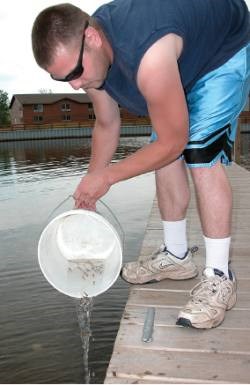NEWS RELEASE
CHIPPEWA OTTAWA RESOURCE AUTHORITY
********************* Tribes stock 0.5 million walleye this summer
20-year stocking program enhances walleye fishing opportunities for all fisheries
SAULT STE. MARIE — Over half a million walleye fingerlings were stocked in the upper Great Lakes by Inter Tribal Fisheries and Assessment Program (ITFAP) this summer.
The tribal fish hatchery, which raises the fingerlings in rearing ponds near Barbeau, is headquartered at Nunns Creek near Hessel, Mich.
Over 280,000 fingerlings went to the St. Marys River and nearby Waishkey Bay got 100,000. Grand Traverse Bay sites received the remaining 125,000.
The two-inch walleye fingerlings are divided between four sites on the St. Mary's.
This year, Potagannissing Bay near Drummond Island was stocked with over 102,000, Lake George on Sugar Island with 67,000, Osborn Park in the Sault with 44,000 and Raber Bay near Goetzville with 68,000.
ITFAP avoids stocking in areas such as Munuscong Bay in order to avoid disruption of the self-sustaining wild populations.
"Our stocking program in the St. Mary's River has been aimed at enhancing walleye fishing opportunities for all fisheries, but we are cautious not to negatively impact the naturally-reproducing walleye population in the river," said ITFAP Director Tom Gorenflo.
Nunns Creek Fish Hatchery is owned by Sault Tribe and operated by ITFAP with funds contributed by Bay Mills and Grand Traverse Band.
The tribal program received assistance for this year's mid-summer stocking from the Department of Natural Resources, which supplied staff for two days to help capture fingerlings from the rearing ponds and transport them to the St. Mary's River stocking locations.
The support helped take pressure off the young two-inchers, thus ensuring a better survival rate.
At the same time, it helped reduce agency costs and improve efficiency.
The two agencies also shared egg collection duties this spring.
The MDNR supplied walleye fry from Bay de Noc for stocking in Grand Traverse Bay, while ITFAP staff collected eggs from adult walleye in the St. Mary's River.
Three days after the eggs hatched, the walleye fry were marked with oxytetracycline (OTC) for tracking purposes and released into the ponds.
This year ITFAP staff hatched 3.5 million eggs.
This fall, the tribe plans to release a number of seven- to nine-inch walleye fingerlings to help strengthen survival rates.
Great Lakes walleye catches have grown considerably in areas stocked by ITFAP since the program started in 1986.
Regions where walleye catch was once low or rare are now cited by angler and state fishing reports as "good" and "improving."
The Chippewa Ottawa Resource Authority (CORA) oversees tribal fishing in the 1836 Treaty-ceded territory of the northern Great Lakes.
Member tribes are Bay Mills Indian Community, Grand Traverse Band of Ottawa and Chippewa Indians, Little River Band of Ottawa Indians, Little Traverse Bay Bands of Odawa Indians, and Sault Ste. Marie Tribe of Chippewa Indians.
For more information see www.1836cora.org.
Photo above shows ITFAP fishery technician Matt Allard releasing the last few of 100,000 fingerlings in Waishkey Bay at the Bay Mills Resort launch site on July 2. Inter Tribal Fisheries and Assessment Program released a total of 380,000 of the two-inch walleye fingerlings at multiple sites in the St. Mary's River this summer, including Raber Bay, Potagannissing Bay, Lake George, Osborn ark and Waishkey Bay. These locations enhance the local fishing opportunities while avoiding wild walleye populations. Photo by Jennifer Dale-Burton.
